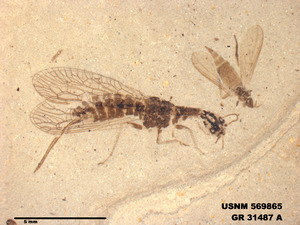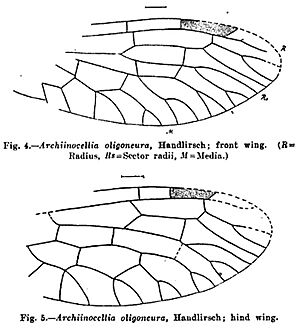Archiinocellia facts for kids
Quick facts for kids Archiinocellia |
|
|---|---|
 |
|
| Archiinocellia protomaculata holotype | |
| Scientific classification |
|
| Kingdom: | Animalia |
| Phylum: | Arthropoda |
| Class: | Insecta |
| Order: | Raphidioptera |
| Family: | Raphidiidae |
| Genus: | †Archiinocellia Handlirsch, 1910 |
| Species | |
|
|
| Synonyms | |
|
|
Archiinocellia is a group of snakefly insects that are now extinct. Their fossils have been found in western North America. These ancient insects lived during the Eocene period, which was about 56 to 34 million years ago.
The Archiinocellia group includes two known species: Archiinocellia oligoneura and Archiinocellia protomaculata. The older species, A. oligoneura, was found in British Columbia, Canada. The younger species, A. protomaculata, was discovered in Colorado, USA.
Contents
Where These Ancient Snakeflies Lived
This section tells us where the fossils of Archiinocellia were found.
Archiinocellia oligoneura Discoveries
The first fossil of Archiinocellia oligoneura was found by a Canadian geologist named Lawrence Lambe. He discovered it on July 21, 1906. The fossil was in rocks near the Horsefly mine in Horsefly, British Columbia.
Archiinocellia protomaculata Discoveries
Fossils of Archiinocellia protomaculata were found in the Green River Formation. This area is in Garfield County, Colorado, in northwestern Colorado.
How Old Are These Fossils?
Scientists use different ways to figure out the age of fossils.
Age of Horsefly Fossils
For many years, people thought the Horsefly sites were from the Oligocene period. This period is younger than the Eocene. However, scientists have now re-dated the site. They found it is actually from the Early Eocene. This makes Archiinocellia much older than first thought. The Horsefly site is part of the Okanagan Highland fossil areas. These areas stretch from Driftwood Canyon Provincial Park in British Columbia to Republic, Washington.
Age of Green River Formation Fossils
The rocks of the Green River Formation are younger than the Horsefly Beds. They are from the Middle Eocene period. This specific time is called the Lutetian stage.
History and How They Were Classified
Scientists study fossils to understand ancient life. They also decide how to group and name different species.
Studying A. oligoneura
The first A. oligoneura fossil was studied by a scientist named Anton Handlirsch in 1910. He named the group Archiinocellia. The name "archi" means "primitive" because the wings looked very old. The second part, "Inocellia," comes from a similar group of snakeflies.
Later, another scientist, Frank M. Carpenter, looked at the fossil in 1936. He noted that the fossil was not in great condition. Because of the damage, he said it was hard to be sure exactly where it fit in the snakefly family tree.
Studying A. protomaculata
Many fossils of Archiinocellia protomaculata have been found. These include a main fossil and several other examples of males and females. Most of these fossils are kept at the National Museum of Natural History in the Smithsonian Institution.
Michael S. Engel first studied A. protomaculata in 2009. He gave it the name protomaculata. This name comes from Latin words. "Protos" means "first," and "macula" means "mark." At that time, it was the only snakefly fossil found in the Green River Formation.
Later, in 2021, scientists Archibald and Vladimir Makarkin re-examined the fossils. They decided that A. protomaculata belonged to the Archiinocellia group. They also placed Archiinocellia firmly within the Raphidiidae family of snakeflies.
What They Looked Like
Here's a description of what these ancient snakeflies might have looked like.
Archiinocellia oligoneura Appearance
The main fossil of A. oligoneura only shows parts of its wings. One is a forewing, and the other is a hindwing. This means scientists cannot tell if it was a male or female, or describe its body.
The preserved part of the wing is about 7 millimetres (0.28 in) long. Scientists guess the full forewing was between 12 millimetres (0.47 in) and 14 millimetres (0.55 in) long. Even with the damage, the wing patterns show unique features. These features help scientists tell this group apart from other snakeflies.
Archiinocellia protomaculata Appearance
A. protomaculata specimens were about 8.33 millimetres (0.328 in) long. This measurement does not include the egg-laying tube (ovipositor) on females. These insects were generally dark brown to brown in color. Their legs were lighter, shading from light brown to yellow.
Their heads were dark brown. They had yellow markings, including stripes along the sides and behind the eyes. There was also a yellow stripe down the center of the head. Female A. protomaculata had a gently curved ovipositor. It was light brown and measured between 3.47 and 3.8 millimetres (0.137 and 0.150 in) long. Their wings were clear, with a slightly darker area called the pterostigma. The forewings were about 7.42 millimetres (0.292 in) long.
Images for kids



